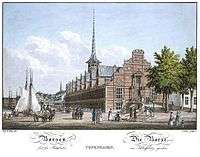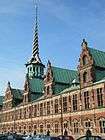Børsen
| Børsen | |
|---|---|
 | |
 | |
| General information | |
| Architectural style | Dutch renaissance |
| Town or city | Copenhagen |
| Country | Denmark |
| Coordinates | 55°40′32″N 12°35′02″E / 55.67556°N 12.58389°E |
| Construction started | 1619 |
| Completed | 1640 |
| Client | Christian IV |
| Design and construction | |
| Architect | Lorentz and Hans van Steenwinckel the Younger |
Børsen (Danish for "Exchange"), also known as Børsbygningen ("The Stock Exchange" in English), is a 17th-century stock exchange in the center of Copenhagen. The historic building is situated next to Christiansborg Palace, the seat of the Danish Parliament, on the island of Slotsholmen. It is a popular tourist attraction. Børsen is most noted for its distinctive spire, shaped as the tails of four dragons twined together, reaching a height of 56 metres.
Built under the reign of Christian IV in 1619–1640, the building is considered a leading example of the Dutch Renaissance style in Denmark. It is a protected building for conservation purposes.[1]
History


Børsen was planned by Christian IV as part of his plan to strengthen Copenhagen's role as a centre for trade and commerce in Northern Europe. A site on the north side of the embankment which connected Copenhagen to the new market town Christianshavn, which was planned on reclaimed land off the coast of Amager. The king charged Lorenz van Steenwinckel with the design of the new building, but Steenwinckel died shortly thereafter. The assignment was then passed on to his brother, Hans van Steenwinckel.[2]
The site first had to be prepared since the embankment had not yet stabilized. Construction of the building began in 1620 and was largely completed in 1624 with the exception of the spire (installed in 1625) and details of the east gable (completed in 1640). The building contained 40 trading offices at the ground floor and one large room at the upper floor. The building was in use as a marketplace during the late 1620s.
In 1647, Christian IV sold the building to the merchant Jacob Madsen for 50,000 Danish rigsdaler. Frederick III later reacquired the building from Madsen's widow.
19th century
In 1857, Frederick VII sold the building to Grosserer-Societetet for 70,000 rigsdaler.
The building was restored by Nicolai Eigtved in 1745 and internally renovated in 1855. It housed the Danish stock-market until 1974. In 1918, unemployed anarchists attacked Børsen, an attack that went to the Danish history books as "stormen på Børsen" (the storm at the stock exchange).[3]
Current use
The building now serves as headquarters for the Danish Chamber of Commerce (Dansk Erhverv).
Gallery
See also
Notes
| Wikimedia Commons has media related to Børsen. |
- ↑ "Sag: Børsen". Fredede og bevaringsværdige bygninger. Kulturstyrelsen. Retrieved 13 April 2016.
- ↑ "The History". Børsbygningen. Retrieved 15 November 2016.
- ↑ "Børsen, Stormen på (1918)" (in Danish). Leksikon.org. Retrieved 15 November 2016.
Coordinates: 55°40′32″N 12°35′2″E / 55.67556°N 12.58389°E


